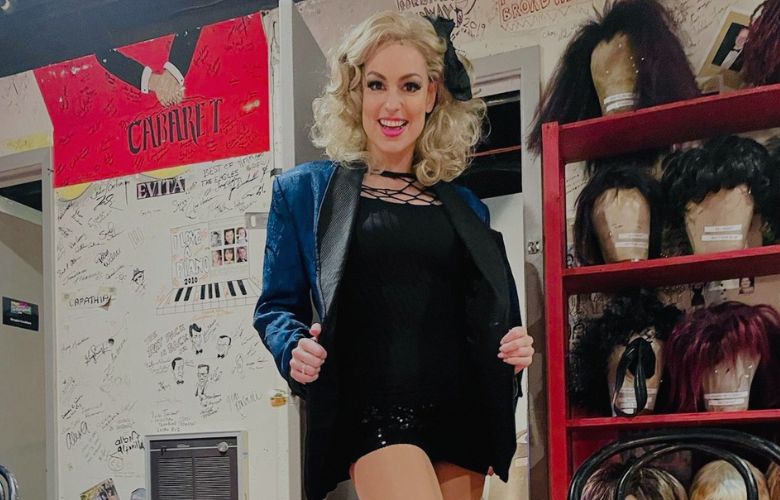
Kim Hudman is an Australian singer, dancer and actor based in the USA. She has performed around the world on cruise lines, has been the principal dancer in the Sands Casino in Macau, and spent two years as dance captain of the two most famous productions at Universal Studios Singapore in addition to performing as lead singer. She has played the critical role of Vivien Pressman and swung for the lead role of Penny Johnson in the Australian national tour of Dirty Dancing.
Hudman has solo’d as the featured dancer with Yvie Oddly for the World Pride Opening Ceremony at Barclay’s Center and has worked with artists such as Whoopi Goldberg, Todrick Hall, Ciara, Chaka Khan and Cyndi Lauper, performing for over 25,000 people, with the event being televised nationally to thousands more. She also featured in RuPaul’s Drag Race star Jan Sport’s music videos and concerts.
Most recently, Kim has performed several notable ‘Swing’ roles, including in On Your Feet and is currently a swing for The Wedding Singer. We caught up with Kim to find out what she’s been up to since our previous chat back in 2020, talking all things performance, artistry, and what it takes to be a swing.
Being a swing truly is the most challenging role and takes a lot of prepping, particularly during the rehearsal process. Every swing records their tracks (roles) differently, I like to have an old school pencil and notebook to draw and map out every single scene, movement transition, prop, set change and blocking.
I then use highlighters for each track I’m covering, and colour coordinate them as they move through the scene. This helps the eye follow the patterning clearly for that specific role and then be able to memorise it.
A swing can learn anywhere between 6 – 12 tracks, so these minor details are important. A “typical” day for a swing during rehearsals would be noting each of these roles down in your book, some use the program Stage Write too for a digital look.
Then, once everything has been notated, each day or rehearsal, you may shadow and follow one role at a time. A swing will watch this person and their every move, mark any changes and all their entrances and exits.
During dance numbers, they will practice the choreography at the back of the space, so as not to be in the way but go through it as if they are that person. The next day, you pick someone new to shadow. The process then flows into rotation until everything is completely memorised.
I live off the challenge and the last minute put ins. I thrive best when thrown into situations at the last minute and the adrenalin is something that you can’t describe. It is very rewarding knowing that you are potentially saving a show.
When someone is sick or injured, the show is compromised if you do not have people to cover; I have even done shows where we had to cancel due to not enough cast members being available to do the show. Therefore, the thought of an entire cast and crew relying on you to step up and do the job is very exhilarating and triumphant.
I believe the only thing that gets me down being a swing is not getting to perform every night with your cast. You could go weeks where everyone is healthy and no covers are needed, and you are just waiting in the dressing room until called. It can get defeating and feel like you are missing out.
As performers, the hunger of being on stage is real and it is a mental challenge knowing that you won’t be on for every show. You have to keep yourself busy and involved in other ways, otherwise it can take a toll on your mental health.
Be prepared to put in the work, particularly during rehearsals. There is a lot of information to note, and the creative team do not wait for you to have it, this must be done in your own time. Write down everything, even if you don’t think it’s important because you may need it later on. Also, look at the smaller details, for example, do you turn on your right or left shoulder, what number on the stage does that person line up with.
All of this attention to detail will make a great swing.
Once the show starts you can relax a little, but give yourself tasks each day to stay busy and motivated. Have a workout/warm up routine so you aren’t cold if you get thrown in mid show, and if you do, take a breath.
No swing ever did well when frantically stressing about going on – remember you were hired for a reason to do this role, so go up there and show them why.
The ebbs and flows of theatre! I am looking forward to having some down time after this, as I went straight from On Your Feet, into holidays and then into The Wedding Singer. However, audition season is upon us, so there will be lots of opportunities coming up and I’m hoping to assist with choreography soon too. I am also getting married in October so 2023 will be a big year!
I think people who aren’t in the industry often don’t know about swings or what the role entails. Most people know what an understudy is and how crucial they are to a show. They definitely are, but it’s important to remember when a star like Hugh Jackman went off from The Music Man, the understudy jumped in and did a fantastic job, but who went on for that person, the SWING!
The swing probably knew 8 different roles in the show and it’s important to recognise the work that swings and understudies do in the industry. We couldn’t do shows without them. When I am in ensemble or another role, I always make sure I thank my swing if they go on for me, because they truly are the rockstars of this industry!
Adrian Angelico: A Virtuoso Trans Male Opera Singer
James “Fitz” FitzSimmons Interview: The Boys In The Band On Netflix


Michelle is a musician and composer from the UK. She has performed across the UK and Europe and is passionate about arts education and opportunities for women and girls.
Read Full Profile© 2021 TheatreArtLife. All rights reserved.

Thank you so much for reading, but you have now reached your free article limit for this month.
Our contributors are currently writing more articles for you to enjoy.
To keep reading, all you have to do is become a subscriber and then you can read unlimited articles anytime.
Your investment will help us continue to ignite connections across the globe in live entertainment and build this community for industry professionals.